Stairway To Heaven
David: When I invited our sons to travel with me in India, I sent each a copy of Lonely Planet. Figuring that it would help induce them to accept the invitation, I told them they could set the itinerary. There was only one exception. I insisted on visiting the Jain temple complex at Palitana, in the state of Gujarat. I had seen images of the complex, which consists of many hundreds of temples on a mountaintop, and there was no way I was going to miss seeing it in person.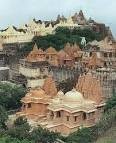 It turned out to be impossible to get to Palitana while the boys were still with me, but Lora and her Gujarat group were ending their tour there. So I slowly wended my way down from Rajasthan to meet them there after the last of the guys finally had to head home.
It turned out to be impossible to get to Palitana while the boys were still with me, but Lora and her Gujarat group were ending their tour there. So I slowly wended my way down from Rajasthan to meet them there after the last of the guys finally had to head home.
Jainism is an ancient religion that was a major faith in the Indian subcontinent until the growth of Hinduism and Islam. One of its highest precepts is to do no harm to any living thing. As a result, Jains are strict vegans. Many of them even avoid garlic, onions, potatoes and other root vegetables because small insects in the soil can be harmed when the plant is pulled out, and also because the roots continue to contain life. Many Jains even try to avoid going out at night because there is a greater risk of stepping on insects after dark. Some wear cloths over their mouths to avoid ingesting any flying insects and to keep harmful words from passing their lips.This ingrained precept against harming living things seems (at least to me) at odds with the Jains having built the Palitana complex, one of their most important pilgrimage sites, on top of a mountain. Can you imagine the pain and suffering from climbing 3,750+ steps to the top of the mountain. By comparison, the Empire State Building has only 1,860 steps. Also, gravity is the law, not just a good idea, so whatever goes up must come down. Therefore, the 3,750+ steps must be descended later the same day because pilgrims and tourists must leave the site before dark.As I was driving toward Palitana, I began to see many groups of women walking along the roadside in the same direction, all dressed in white. I assumed they were pilgrims, and they came in all ages, sizes, conditions and shapes. How, I wondered, could the elderly, infirm and crippled possibly make a climb to the top?Two ways, it turns out. For the infirm and crippled pilgrims there were sedan chairs, flimsy plastic lawns chairs lashed to a couple of large bamboo poles shouldered by four strong men. The other way was for daughters and other young women to push their elders up the mountainside from behind.Lora and I elected to climb, not ride, even knowing that we’d have to do it without the aid of a son (all of whom had already flown home) pushing us up the steps from behind. I began to worry about half way up when four young men carrying an empty sedan chair started walking alongside me. The closest one kept whispering in my ear: “Grandpa, you need to ride.” My concern was that these guys are probably better than me at predicting who won't be able to make it to the top, and they were circling me like vultures. To convince them that I didn’t need their services, I took over one of the porter positions on a passing sedan chair that was carrying a woman in Lora’s group. “Grandpa” and Lora made to the top.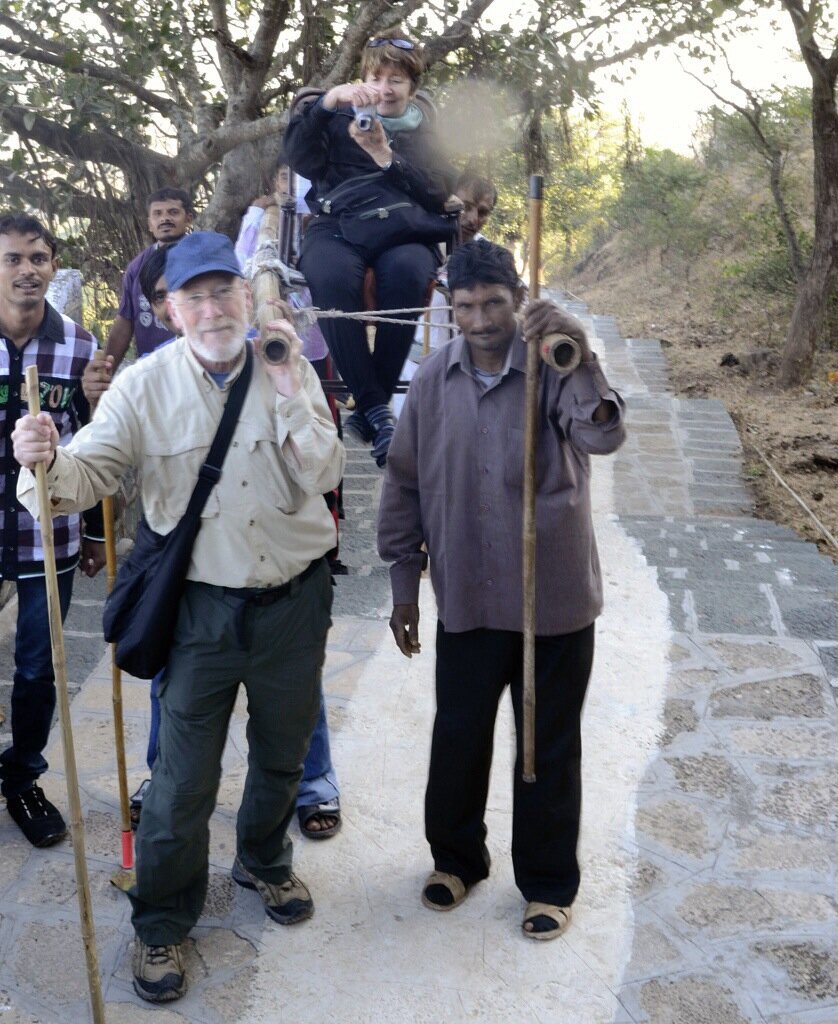 Our calves screamed for days, but it was worth it. Photos of the climb, the temples and the descent are in Lora's next posting.One suggestion for any of you who might visit Palitana – carry some food or high-energy snacks. After climbing 3,750 steps, it’s easy to get templed-out on an empty stomach and your temple/step ratio will drop precipitously.There are two other Jain temples I need to mention, both Rajasthan. One is in the village of Dilwara. The other is in Ranakpur.Ranakpur is on the road from Udaipur to Jodhpur. (More on our experiences in those cities in future postings.) The temple must cover at least 3-4 acres. It is a massive open interior structure varying from one to three levels in which more than 1,400 columns support the roof. The columns are intricately carved, and each is in some detail unique from all the others. Intricate carvings also cover other surfaces, including the interior surfaces of many domes high overhead. The effect was as overwhelming on my third visit, with Sam, as it was with Max in 1994 and Lora in 2010.
Our calves screamed for days, but it was worth it. Photos of the climb, the temples and the descent are in Lora's next posting.One suggestion for any of you who might visit Palitana – carry some food or high-energy snacks. After climbing 3,750 steps, it’s easy to get templed-out on an empty stomach and your temple/step ratio will drop precipitously.There are two other Jain temples I need to mention, both Rajasthan. One is in the village of Dilwara. The other is in Ranakpur.Ranakpur is on the road from Udaipur to Jodhpur. (More on our experiences in those cities in future postings.) The temple must cover at least 3-4 acres. It is a massive open interior structure varying from one to three levels in which more than 1,400 columns support the roof. The columns are intricately carved, and each is in some detail unique from all the others. Intricate carvings also cover other surfaces, including the interior surfaces of many domes high overhead. The effect was as overwhelming on my third visit, with Sam, as it was with Max in 1994 and Lora in 2010.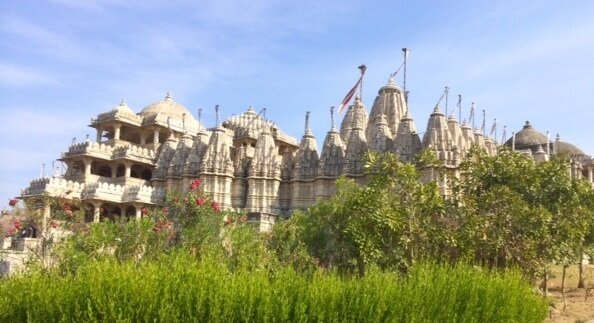
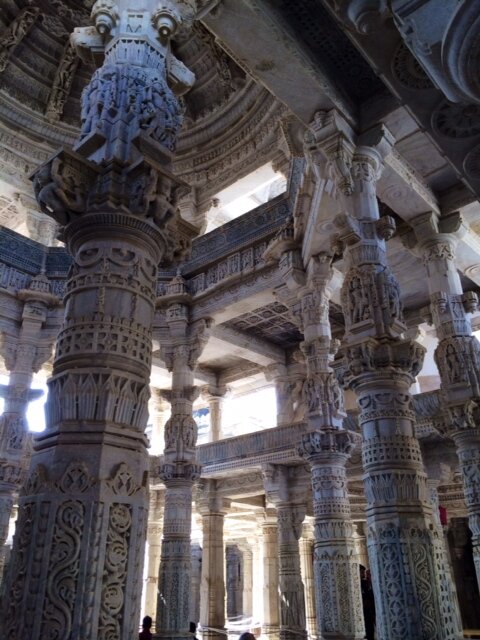
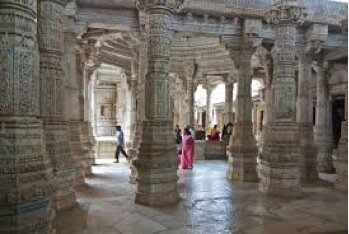
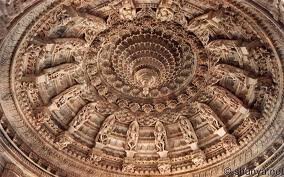
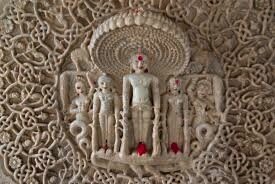
 The Dilwara temples are at the Rajasthan hill station Mt. Abu, where I did an overnight on my way to meet up with Lora at Palitana. They are less than a tenth the size of Ranakpur. The carvings are comparable (as shown above), but because of Dilwara’s much smaller size, they feel breathtaking in their intimacy rather than overwhelming as at Ranakpur.
The Dilwara temples are at the Rajasthan hill station Mt. Abu, where I did an overnight on my way to meet up with Lora at Palitana. They are less than a tenth the size of Ranakpur. The carvings are comparable (as shown above), but because of Dilwara’s much smaller size, they feel breathtaking in their intimacy rather than overwhelming as at Ranakpur.
